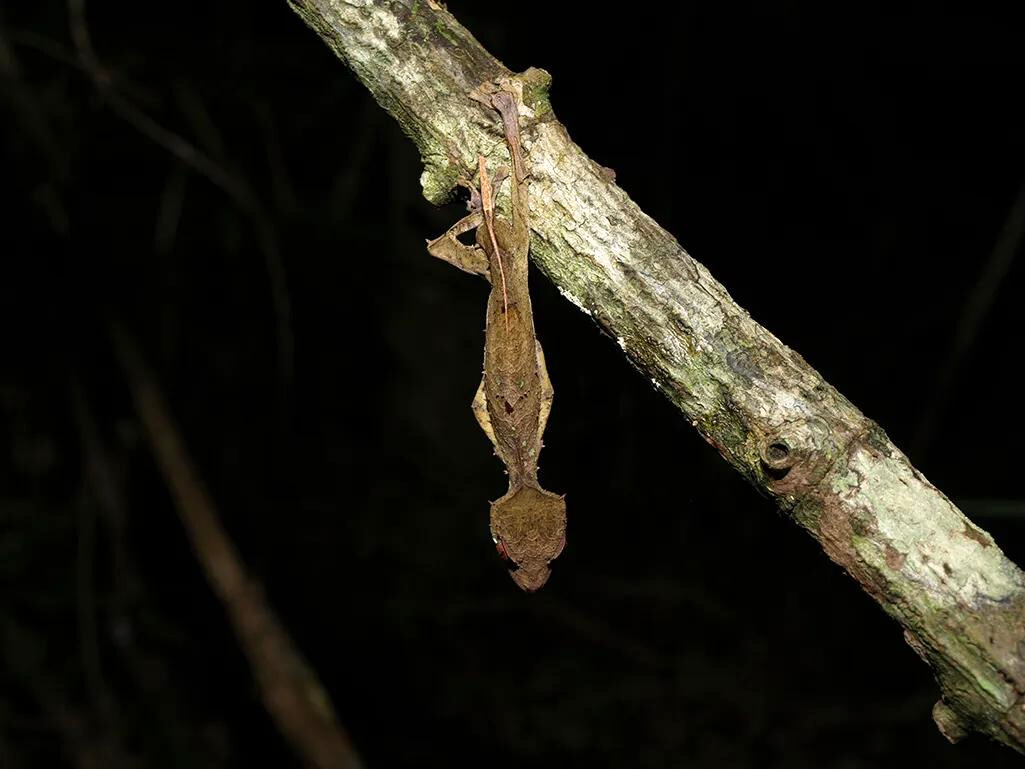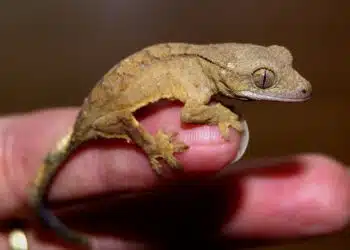Hidden in Plain Sight: The Leaf Gecko’s Incredible Camouflage
Welcome to the hidden world of the leaf gecko, a master of disguise nestled in the lush landscapes of Madagascar’s Andasibe-Mantadia National Park. This small reptile is a marvel of evolution, perfectly adapted to blend seamlessly into its leafy surroundings. It is important to mention that the leaf gecko’s ability to camouflage itself is not just a mere survival tactic. Simply, it is an intricate dance of colour, texture, and behaviour that fools predators and observers alike.
But why does the leaf gecko need such sophisticated camouflage? Situated in the eastern rainforests of Madagascar, the Andasibe-Mantadia National Park is a biodiversity hotspot teeming with life, where every creature must carve out its niche or fall prey to another. Here, the leaf gecko uses its unique skills to thrive in a competitive ecosystem.
Consider this: when looking at a branch full of leaves, can you distinguish a creature that looks exactly like one of the leaves? The leaf gecko challenges our perceptions, making us question what we see. In the next sections, we’ll explore how this incredible lizard blends so well into its environment, ensuring its survival in a complex world.

1. Overview of the Leaf Gecko
The leaf gecko, a small reptile native to Madagascar, is a remarkable example of nature’s ingenuity in design. This lizard typically measures between 3 to 6 inches in length, making it a perfect size to blend into the foliage of its environment. Its skin mimics the textures and colours of leaves, complete with vein-like patterns that vary from green to brown. These colours can also change based on the lighting and the temperature, helping the gecko remain undetected by predators and prey alike.
In terms of species specifics, the leaf gecko belongs to a group known for their adaptive camouflage. This trait is crucial for their survival, as it allows them to hunt insects stealthily and avoid birds and larger mammals that roam the rainforests of Madagascar.
The ecological role of the leaf gecko in Madagascar’s biodiversity is significant. As a predator, it helps control the populations of insects, which might otherwise become overabundant and affect plant life detrimentally. The leaf gecko also serves as prey for larger animals, making it an integral part of the food chain. This balance helps maintain the health of the forest ecosystem, ensuring that both plant and animal communities thrive. By inhabiting the dense foliage, the leaf gecko contributes to the biodiversity that makes Madagascar’s forests rich and varied.
2. The Science of Camouflage
Camouflage in nature is a method by which an organism blends into its environment to hide from predators or to ambush prey. This biological phenomenon is widespread across many species. Here, this is particularly in those where avoiding detection is key to survival.
The leaf gecko is a prime example of camouflage at its finest. Its skin colouration perfectly matches the decaying leaves of its forest habitat. Browns, greens, and tans paint the gecko’s body, with patterns that mimic the specific texture of leaves, including their lines and edges. This colouration is not static; the gecko can adjust its hue based on the surrounding conditions, becoming darker or lighter in response to the light levels and background colours.
Moreover, the shape of the leaf gecko’s body complements its deceptive appearance. Its flat, broad body and limbs allow it to lie very close to tree trunks and branches, reducing shadows and merging its outline with the leaves. This shape, combined with a still, patient behaviour, makes it almost indistinguishable from the actual foliage.
The benefits of such effective camouflage are significant. For one, it helps the gecko avoid predators like birds and larger mammals. By blending in, it becomes almost invisible to these threats, allowing it to survive another day. Additionally, this camouflage aids in hunting. The leaf gecko can remain undetected as it waits for insects to come within reach. Once prey is close enough, it strikes quickly, using the element of surprise to its advantage. This method of hunting is efficient and conserves energy, which is crucial for survival in the wild.
In essence, the leaf gecko’s camouflage is a sophisticated survival tool, that evolved over millennia to perfect the art of invisibility in plain sight.

3. Habitat and Lifestyle
The Madagascar Andasibe-Mantadia National Park contains a highly rich ecological niche, which comprises evergreen moist forest and signs of high rainfall, thereby making it a highly humid area. This park covers about 155km² of this region and has many species of flora and fauna that are endemic to this region of Zambia.
The eco-climate of this type of habitat is excellent for the natural habitat of the leaf gecko where it hides well under the intricacies of overgrowth of foliage in this damned national park. The existence of strata of trees ensures the little gecko has many spaces to hide and feed off because of there being many types of plants. Thanks to the autumn environment, blades of grass, branches, and trunk behind the underbrush form an excellent camouflage for the species since any movement or flash of color is easily detected in the shade.
Tending to the needs of a leaf gecko consists of several important activities tied around the life of this creature and its basic strategies for survival of a particular day. I expect that during the day, leaf geckos are likely to be inactive, mostly found in the upside down side of the leaves or laying flat along the trunk of trees. They are almost hidden from any form of predators or chances of getting food. This also helps save energy as well as remain in great obscurity especially from the male sex chasers.
Another activity that affects leaf geckos is the fact that these are active animals at night when they are searching for food. Insects are the only sources of food that they get through tact by approaching the insects in a surprising manner. The combination of dark night with their ability to blend into the environment is very effective, thus turning into excellent hunters who are able silently get close to their prey. They retire to the selected area, offering themselves up for nyctalopsing once the first light comes in the morning.
The cyclical pattern of resting by day and being active by night suits the lifestyle and survival needs of the leaf gecko, perfectly complemented by the natural habitat provided by Andasibe-Mantadia National Park. This daily routine ensures they maintain enough energy for nocturnal activities and remain safe from daytime predators.
4. Threats and Conservation Status
Do you know how the life of the leaf gecko can easily conceal itself from birds, snakes, and monitor lizards? Having numerous threats resulting from human activity and changes in the environment. The subsequent increase in the conservation status of this peculiar reptile is worrying given the fact that its natural habitat is being steadily eliminated due to issues of deforestation and habitat fragmentation. The following are as environmental pressures brought about by logging, agriculture, and human settlements.
Additionally, climate change poses a significant threat to the leaf gecko’s environment. Shifts in temperature and weather patterns can alter the ecosystem of Andasibe-Mantadia National Park, impacting the delicate balance of humidity and temperature that the geckos rely on for survival.
In response to these threats, conservation efforts are being implemented to protect the leaf gecko and its habitat. Organizations, both local and international, are working to promote sustainable forestry practices and establish protected areas where the gecko and other native species can thrive. Environmental education programs are also essential, raising awareness among local communities about the importance of preserving the biodiversity of Madagascar.
Research into the specific needs and behaviours of the leaf gecko is another crucial aspect of conservation efforts. By understanding more about their lifestyle and ecological role, conservationists can better tailor their strategies to ensure the survival of this incredible species. These initiatives are vital not just for the leaf gecko but for the entire ecosystem of Madagascar, which depends on the balance and health of every species within it.
5. Observing the Leaf Gecko in the Wild
Spotting a leaf gecko in its natural habitat requires patience, keen observation skills, and a bit of know-how. Here are some tips to help you see one of these elusive creatures:
Visit During Optimal Times: Leaf geckos are nocturnal, so your best chance to observe them is at dusk or during early night hours when they are active. During the day, they are often hidden and stationary, making them much harder to spot.
Look for the Details: Pay attention to the shapes and colours of the leaves around you. Leaf geckos are excellent at mimicking their surroundings, so look for any leaf that seems out of place or has an unusual contour.
Move Slowly and Quietly: Sudden movements or loud noises can disturb geckos and other wildlife, making them retreat or hide. Slow, deliberate movements will help you blend more into the environment. For those looking to enhance their experience, local guides and specialized wildlife tours are available in Madagascar, particularly around Andasibe-Mantadia National Park. These guides are knowledgeable about the gecko’s behaviours and habitats and can increase your chances of a sighting. They can also provide fascinating insights into the gecko’s life and the ecosystem it inhabits.
When participating in wildlife watching, it’s crucial to follow ethical practices:
Maintain a Respectful Distance: Avoid getting too close to wildlife, as this can cause stress to the animals and potentially disrupt their natural behaviours.
Do Not Feed the Animals: Feeding wildlife can alter their natural hunting behaviours and diet.
Stay on Designated Paths: This helps minimize environmental impact and reduces the chances of disturbing the habitat.
Respect Local Guidelines and Regulations: Adhering to the rules set by wildlife.

Conclusion
The leaf gecko’s ability to vanish into its surroundings is not just a curious detail; it’s a critical survival mechanism. This remarkable camouflage protects it from predators and enables it to be an effective hunter, maintaining the delicate balance of its ecosystem. Hidden in the foliage of Madagascar’s Andasibe-Mantadia National Park, the leaf gecko exemplifies the incredible adaptability and beauty of nature.
However, the survival of the leaf gecko is not guaranteed. It faces numerous threats, primarily from habitat destruction and environmental changes. Preserving their natural habitat is crucial, not just for the geckos, but for the myriad of other species that share their environment. Each creature plays an integral role in the biodiversity of Madagascar, one of the world’s most unique ecosystems.
We can all contribute to the efforts to conserve this precious wildlife. By supporting conservation projects and promoting responsible ecotourism, we help ensure that future generations can also marvel at the wonders of nature. Whether you are visiting these habitats or advocating from afar, every action counts.
Therefore, do not miss the chance to join in the efforts to keep these unique creatures not just hidden in plain sight, but safe and thriving in their natural home?
Also you can read an article about In Search of the Amethyst: Discovering Purple Mushrooms in the Forest and more amazing articles in our website Bamboospanda.









